The following are the baseball events of the year 1874 throughout the world.
Antipodolycaena is a subgenus of the genus Lycaena which is found only in New Zealand. Antipodolycaena includes four species that are endemic to New Zealand:

Arachnura, also known as drag-tailed spider, scorpion-tailed spider and scorpion spider, is a genus of orb-weaver spiders that was first described by A. Vinson in 1863. They are distributed across Australasia, Southern and Eastern Asia with one species from Africa. Females can grow up to 1 to 3 centimetres long, while males reach only 2 millimetres (0.079 in) long. The name is a combination of the Ancient Greek "arachne-" (ἀράχνη) and "uro" (οὐρά), meaning "tail". The tails are only present on females, but unlike the common names suggests, these spiders aren't related to scorpions. They curl up their tails when disturbed, but they are completely harmless. Bites are rare, and result in minor symptoms such as local pain and swelling. They stay at the middle of their web day and night, and their bodies mimic plant litter, such as fallen flowers, twigs, or dead leaves.
The 1874 Chicago White Stockings season was the third season of the Chicago White Stockings franchise, the second in the National Association of Professional Base Ball Players and the first at 23rd Street Grounds. The White Stockings returned to the league in 1874 after taking two years to recover from the chaos of the Great Chicago Fire. They opened their season on Wednesday May 13 hosting the Philadelphia Athletics and shut them out 4 to 0. They finished fifth in the National Association with a record of 28–31.
The 1874 Boston Red Stockings season was the fourth season of the franchise. They won their third consecutive National Association championship.

Platyninae is a subfamily of ground beetles.

Notagonum is a genus in the beetle family Carabidae. There are more than 80 described species in Notagonum.

Leptostylus is a genus of longhorn beetles of the subfamily Lamiinae. It was described by John Lawrence LeConte in 1852.

Elaphidiini is a tribe of beetles in the subfamily Cerambycinae, historically also often spelled "Elaphidionini".
Notagonum gibbum is a species of ground beetle in the subfamily Platyninae. It was described by Darlington in 1952.
Notagonum spinulum is a species of ground beetle in the subfamily Platyninae. It was described by Darlington in 1952.
Notagonum astrum is a species of ground beetle in the subfamily Platyninae. It was described by Darlington in 1971.
Notagonum curiosum is a species of ground beetle in the subfamily Platyninae. It was described by Darlington in 1971.
Notagonum anops is a species of ground beetle in the subfamily Platyninae. It was described by Jedlicka in 1934.
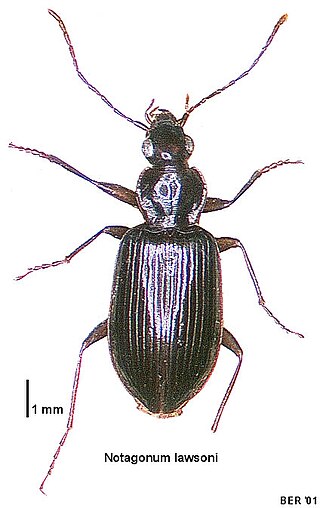
Notagonum lawsoni is a species of ground beetle in the subfamily Platyninae. It is endemic to New Zealand. It was described by Bates in 1874. Notagonum lawsoni has been collected from Metrosideros excelsa through the beating of foliage.
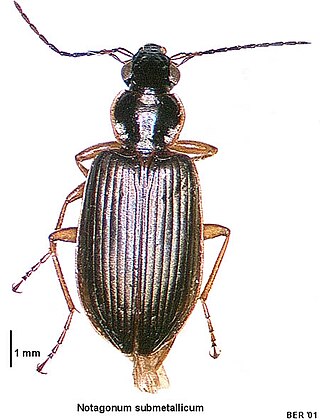
Notagonum submetallicum is a species of ground beetle in the subfamily Platyninae. It was described by Adam White in 1846.
Notagonum kitchingi is a species of ground beetle in the subfamily Platyninae. It was described by Baehr in 2010.
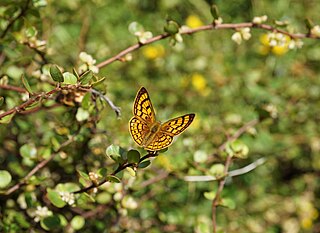
Lycaena rauparaha, Rauparaha's copper, Fereday’s copper or mokarakare is a species of butterfly endemic to New Zealand. It acquired its English common name because it occurred in the same coastal areas as the rangatira (chief) and war leader of Ngāti Toa Maori, Te Rauparaha.
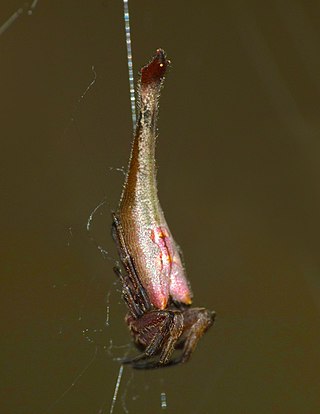
Arachnura feredayi, the tailed forest spider, scorpion spider or drag-tailed spider, is endemic to New Zealand. It is known for the distinctive tapering body shape in females, which are also much larger than males, and for producing vertical columns of egg sacs in their webs.
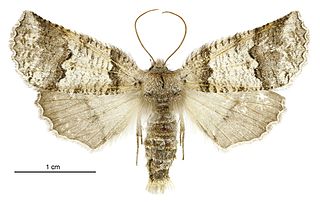
Declana feredayi is a species of moth in the family Geometridae. It is endemic to New Zealand. Adults of this species pollinate Hoheria Iyallii.








